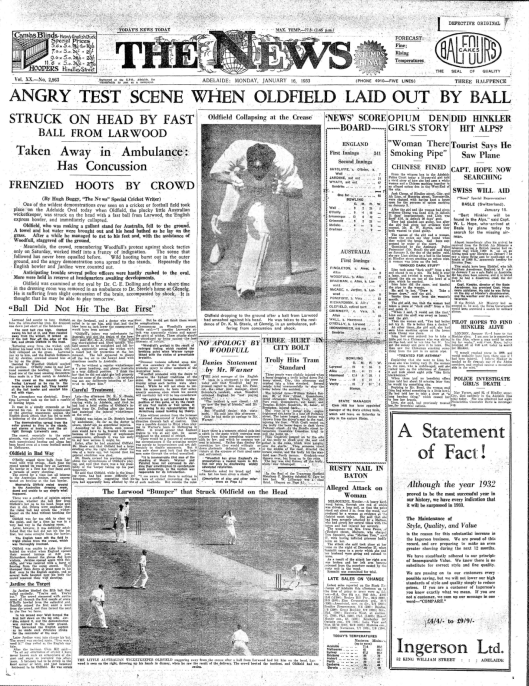My cousin has been watching the cricket test between England and Australia at the Adelaide Oval over the last few days. It reminded me of an anecdote about our great grandmother Kathleen Cudmore née Cavenagh-Mainwaring (1874-1951).
Our Cudmore great grandparents lived at Pennington Terrace, Adelaide, very close to the oval.

My great grandparents’ house on Pennington Terrace

Map showing 64 Pennington Terrace and the Adelaide Oval
My grandmother told me that when the infamous “bodyline” test was being played, her mother was about to leave the house but turned around, bolted the shutters and locked the doors because from the loud and violent roar of the crowd she was afraid there might be a riot.

A huge crowd — 50,962 — turn out at Adelaide Oval on January 14, 1933, for the Test match between Australia and England, during the Bodyline war. From The Advertiser 26 November 2017 The Remarkable History of the Adelaide Oval http://www.adelaidenow.com.au/news/south-australia/the-remarkable-history-of-adelaide-oval/news-story/f92d8b823514f49538681af751de26fc
Bodyline bowling was used by the English cricket team against the Australians in their tour in the summer of 1932-1933, 85 years ago. At that time the Australian cricketer Donald Bradman was hugely successful with a batting average at the time which was twice that of all other world-class batsmen. The English decided to bowl at the body of the batsman in the hope that it would limit the ability to score runs and that when the batsman defended himself with his bat, the deflected ball could be caught by one of several fielders standing close by.
The third test match of the series between England and Australia in 1932-33 was played at the Adelaide Oval from 13 to 19 January 1933. England won but their bodyline bowling was highly criticised. On the second day of the test the crowd watching was over 50,000, a record sized crowd. A ball bowled by Harold Larwood struck Bill Woodfull over his heart. Play was halted and the English team used the opportunity to move their fielders into position to maximise the effects of bodyline bowling. The spectators became angry. It was probably this that caused my great grandmother to return indoors and secure her house.

(1933, January 16). News (Adelaide, SA : 1923 – 1954), p. 1. Retrieved December 5, 2017, from http://nla.gov.au/nla.news-page11062700
When I was a young girl, watching cricket at the oval with my grandmother and step-grandfather was a summer tradition. I remember seeing Lillee and Thommo bowl. They were fast bowlers with very long run-ups. They were said at the time to be “the fastest pair [of bowlers] ever to have coincided in a cricket team”. A cartoon at the time of the 1974-75 Ashes tests was captioned “Ashes to Ashes, dust to dust, if Thomson don’t get ya, Lillee must.” I was also a great fan of the wicket keeping of Rod Marsh.
For me though, watching cricket was spoiled forever afterwards by the directive that the Australian captain Greg Chappell gave to his brother Trevor Chappell to bowl underarm in a game against New Zealand in 1981. The New Zealanders needed to hit a six off the final ball to tie the game. Bowling a mullygrubber was extraordinarily unsportsmanlike. I remember watching the incident with my maternal grandfather in his kitchen. The crowd at the time booed the Australian team from the field.
Other posts about my great grandmother
- Trove Tuesday: Kathleen Cavenagh dressed for a children’s ball in 1887
- A silhouette of Mrs Cudmore
- F is for fundraising
- N is for Naval husbands
- Sepia Saturday: burglary

Hello Anne my grt uncle Walter Frederick Andrews married Violet Cudmore (she was the daughter of James Francis Cudmore and Margaret Budge) Walter and Frederick moved to Perth and then Narrogin. He was a solicitor and also the mayor of Narrogin they had three children – two daughters and a son.
Cheers Kaye
LikeLike
Hi Kaye. Great to hear from you. I included a picture of Violet in the post https://ayfamilyhistory.com/2013/12/08/trove-tuesday-kathleen-cavenagh-dressed-for-a-childrens-ball-in-1887/ . Violet was at the ball also as was her brother Arthur my great grandfather.
LikeLike
Pingback: Kiss and be kissed | Anne's Family History